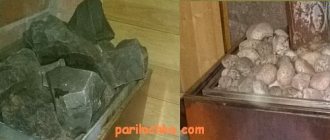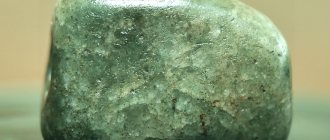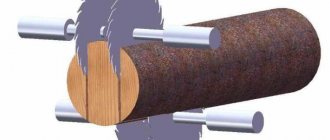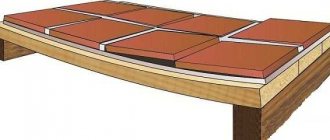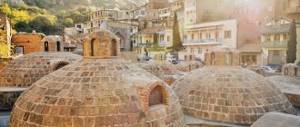This stone has another name - gabbrodorelite and is one of the most common natural stones, which fully meets the requirements of the 1998 State Standard for rock blocks for the production of facing, memorial, architectural, construction and other products. And if the finishing gabbro-diabase for a bathhouse needs to be decorated and polished, then the bulk one for a stove-heater is suitable in the state of stone fines directly from the face of the quarry. And in this form it will probably be the cheapest option for stone backfill. As they like to say at one well-known imported market: “It’s not cheaper, don’t look for it.”
What is the breed
As you can already judge from the name, this stone is a “transitional” link between diabase and gabbro. According to its characteristics, the rock is close to basalt and granite. It is a gabbro-diabase stone of a dark gray or greenish color. It contains, for example, minerals such as:
- titanomagnetite;
- plagioclase;
- pyroxenes;
- amphiboles.
None of these types of minerals release harmful substances into the air. And this is, of course, a big advantage of gabbro-diabase as a stone used in industry, construction and everyday life.
Properties and contraindications of the stone
We will get to contraindications below; in general, this formulation of the question should be given special attention. But there’s nothing wrong with properties—all things have unique sets of properties that make them either suitable or unsuitable for the tasks assigned to them by man.
What is good about its mineral and chemical composition?
87% of the entire rock mass of the Earth is silicates or silicon compounds. But diversity from such chemical uniformity is obtained due to different percentages of silica and other oxides, as well as rarer impurities under different conditions of crystal formation.
As for the chemical composition of gabbro-diabase, it is practically indistinguishable from the chemical composition of basalt - this is the same magma of basic (=alkaline) composition, which crystallized at a different depth than basalt. The latter circumstance is responsible for which crystals are formed, and whether they are formed at all.
Here is the average percentage chemical composition of basalt :
- Al₂О₃ 12-17%
- MgO 7-15%
- CaO 6-13%
- FeO 4-14%
- Fe₂О₃ 0.5-11%
- Na₂О 1.5-3.5%
- TiO₂ 1.0-2.5%
- К₂О 0.1-2%
- Р₂О₅ up to 0.6%
- MnO up to 0.3%
You see that it all consists of fairly inert oxides. Bath temperatures cannot destroy them; they were formed at higher temperatures. So for a bathhouse, the chemical properties of gabbro-diabase are essentially indifferent, since they pose neither a threat nor a benefit (may fans of the healing power of stones forgive us - we are not experts in this field).
However, please note: we are talking about an average composition! And it says nothing about, for example, that sulfur - both elemental and in the form of oxides - is one of the components of liquid magma. When cooling, it usually “pulls” metals from the magma, forming, for example, sulfides, which in the form of the same pyrite (iron sulfide) can crystallize inside the future gabbro-diabase.
But it is sulfides that are those impurities that can harm the health of the steamer. If there are stones in the heater with an admixture of sulfides, then with strong heating they will disintegrate, forming sulfur oxides, whose reaction with water forms acids. Inhaling their vapors burns the respiratory tract - it feels like a stinging, sore throat. It also hurts the eyes. In addition, it was not for nothing that the smell of sulfur and its compounds was considered “hellish.”
The presence and amount of sulfides depends on the composition of the magma in a particular area.
Do not think that sulfides are a specific “problem” of gabbro-diabase. In fact, this applies to all igneous rocks. And it will be problematic only in relation to the bathhouse. In general, sulfides are one of the types of ores from which people have been extracting metals since ancient times. In addition to compounds with sulfur, metals are also reduced from oxides.
The time of rock formation is so remote from the present moment that some changes could have occurred to them after the magma solidified. In particular, partial or complete replacement of some minerals could have occurred, which also means a change in chemical composition . But it is unlikely that stone sellers will distinguish between the usual and the substituted rock.
Those who find out the properties of gabbro-diabase as a stone for a bath should pay attention to the deposit, but we will talk about this a little further in this article.
The minerals that make up gabbro-diabase depend on the conditions of its formation. And here we risk first delving into the intricacies of the correct naming of this stone, which precisely depends on the conditions of formation and replacement of some minerals by others. In general, you can read an even more complete article about the properties on our website.
Well, for now let’s just say that typical for gabbro-diabase is the content of approximately equal proportions of plagioclase and colored minerals (usually pyroxenes), as well as small amounts of accompanying ore minerals (in particular, those same sulfides, but they are, in fact, rather an exception than the rule).
The mineral composition of gabbro-diabase for a bath is important only in terms of sulfide content - if there are a lot of them, then you should refuse to purchase such a stone. If it’s a little, you can hope that they will burn out during the first fires.
How to identify sulfides? Quite simply: look on the surface for small cubes and other crystalline formations that have a gray or yellow color and a distinct metallic luster, that is, they shimmer in the light like metal. Yes, that means opening each box and examining the stones.
Bath stone: what physical properties are good for using in a heater?
First of all, let's remember what a stone encounters in a bathhouse and what is expected of it.
The stone can be used either to produce light steam , finely dispersed, that is, superheated (steam temperature above 100 degrees), or simply as a heat accumulator in sauna heaters. To obtain steam from a Russian bath, the stones need to be heated to a temperature of about 400 degrees. But it happens that they heat up even more.
If you even splash boiling water on an overheated stone, there will be a significant temperature difference. There will be an instantaneous transfer of heat to the water, which will evaporate in the form of superheated steam. But the stone will experience a large temperature load , which will destroy it over time.
There are also heaters in batch kilns , in which the stone is directly washed by fire. This heat load further reduces its lifespan, after which it simply crumbles into sand.
In other words, closed heaters and batch kilns require stones that are strong and can withstand high heat and rapid cooling.
Such conditions are best met by stones of igneous origin , which were formed at great depths (more than 2 km). Gabbro-diabase is of igneous origin, but its formation depth is less than 3 km. It is less durable than dunite or jadeite. But its low cost compensates for the inconvenience created by the need to periodically touch the heater.
Those who love saunas know that stones can “shoot” - scatter into pieces inside the stove with a loud bang. What does this come from? Those stones shoot, that is, they split with noise, in which uneven thermal expansion leads to instant destruction. And this depends on the structure and mineral composition. It also depends on the fracturing of the stone itself, but in any case, the active factor is temperature.
Even solids increase their volume under the influence of heat. The smaller the crystals of the stone, the more uniform the structure, the more evenly it will expand. Gabbro-diabase for a bath is good precisely because of its homogeneous structure and small crystals .
Video showing the results of the bulkhead
In general, to summarize: gabbro-diabase is suitable for a bathhouse, but its performance is still not the best, and this, in turn, is compensated by its low price.
Are there any contraindications for using stones in the bath?
Since people ask specifically about “contraindications,” I would like to clarify this issue. Well, it is clear that it came from medicine, and in this sense, of course, cannot be considered at all, unless one indulges in free speculation about the “healing properties of stones.”
But we do not think that any Paracelsus or ancient Chinese doctor, speaking about the effect of stones on the human body, had in mind half a ton of gabbro-diabase in a sauna stove.
Still, you can be rational and consider that the main task of the stone in a sauna stove is the accumulation and transfer of heat. Both ceramics and metal successfully cope with this task. In this sense, it is contraindicated to use... yes, the same marble or granite, that is, something that will not withstand the conditions of heating and cooling.
In general, don't complicate what's simple. The heart and blood vessels are much more influenced by the temperature and humidity ratio in your steam room than the type of stones in the stove.
Where can it be used?
According to sanitary and hygienic standards, gabbro-diabase stone is one of the rocks permitted for use in construction with background radiation not exceeding permissible standards. This material is used quite widely in industry.
One of the features of gabbro-diabase is its interesting fine-grained structure. This stone is polished better than, for example, granite and basalt. Therefore, it is sometimes used as a facing material in the construction of buildings and structures. This breed can also be used:
- for the manufacture of paving stones (for example, exactly this material was used on Red Square in Moscow);
- in precision engineering.
Very often, tombstones are made from such stone. Polished black gabbro-diabase looks very solid and presentable. Therefore, tombstones made from it, like no other, create an appropriate mournful and solemn atmosphere at the burial site. For the manufacture of monuments, Karelian diabase is usually used, which can maintain polish for a long time.
Very often this breed is used to create optimal temperature conditions in baths. That is, they simply put these inexpensive stones in the heaters. Dense gabbro-diabase can retain heat very well and for a long time. In addition, the material is absolutely environmentally friendly.
Like granite, gabbro-diabase is often used in the interiors of apartments and houses. This material is used, for example, to make countertops, railings and window sills. Such products actually look very impressive. In addition, they also have very good performance characteristics.
Types of stone
A popular stone is gabbro-diabase. The Karelian fossil is unique, since in terms of physical and chemical properties it has no competitors in Russia. The approximate volume of mined deposits is around 4 million cubic meters.
The composition of the rock retains heat well and transfers it. Also, the fossil does not lose its artistic qualities and polishing characteristics for a long period. In the whole world there are only two areas with mineral deposits - Australian and Ukrainian.
The mineral is classified by content and composition. The monolith contains quartz, ilmenite, olivine, biotite, chlorite compounds, which give the rock its green color, calcite, and limonite.
The composition of the breed is:
- augite - a species from North Wales that has grains of augite.
- albite - diabase from Krasnaya Polyana in the Caucasus, described by Belyankin.
- amphibole - among the minerals of which there is primary brown hornblende, which is sometimes abundant, and sometimes in a subordinate amount to augite.
- analcime - a vein-grained variety with analcime, which most likely, as in augite teschenite, was formed from nepheline.
- anorthite.
- bronzite.
- variolite - from Temelpace Mountain, California. It consists of oligoclase laths in subordinate quantities and thin augite prisms, which are placed in the groundmass consisting of calcite, chlorite and leucoxene.
- diallag - a variety with a predominance or exclusive dominance of diallag.
- dipyr - formed from dipyr and salite-like augite.
- aphanitic - at a given moment in time it is paleotype basalt or basaltic porphyrite.
- vein - A paleotype mafic vein rock consisting primarily of mafic plagioclase and augite.
- grainy.
- needle.
- quartz - together with pyroxenes and basic plagioclase, it contains quartz. Potassium feldspar is often present together with quartz, forming micropegmatite intergrowths with quartz.
- malacolithic.
- amygdaloid - consists of oligoclase, individual crystals of albite and relict grains of augite, enclosed in the groundmass of chlorite, calcite, ilmenite and leucoxene.
- olivine.
- pegmatite.
- ash.
- porphyritic.
- spotted - a breed of the Upper Harz, previously classified as variolites.
- hornblende.
- salite - diabase having many euhedral crystals of monoclinic pyroxene.
- syenite.
- mica - more or less significant content of biotite.
- saussurite - more or less saussuritized feldspar.
- teralite.
- spilite - from Weilburg, Germany.
- tuff - dense augite porphyrite, light, dark gray or black from Keweenaw Point.
- uralite.
- ball.
- alkaline.
- enstatite.
- essexitic - alkaline diabase of the essexite-teralite series, in contrast to ordinary diabases of the gabbro type. Sometimes contains nepheline, aegirine or alkali amphiboles.
- aplite - consists primarily of feldspar group minerals and was formed not by the injection of granite into diabase, but by the splitting of the same magma into two rocks.
Deep in volcanic rocks, minerals can form large deposits and sills. Crimean mineral is the cheapest. It consists of iron impurities, which reduces its quality.
Physical properties of the rock
The properties of gabbro-diabase, among other things, are distinguished by the following:
- High degree of density - 3.07 g/cm3.
- Compressive strength - 311 MPa.
- Low degree of abrasion - 0.07 g/cm2.
This stone is also characterized by frost resistance. Gabbro-diabase tolerates temperature changes well. The breed can withstand up to 300 cycles of temperature fluctuations without harm. The radioactivity of this material is up to 74 becquerel/kg. In terms of strength, this type of diabase surpasses even granite.
Diabase composition
The mineralogical composition of diabase corresponds to the mineral composition of gabbro: plagioclase, olivine, labradorite, pyroxene. In the case of a porphyry structure, small elongated grains of white feldspars (plagioclase) are clearly visible, having regular outlines against a dense or fine-grained background.
Chemical composition : SiO2 43-52%, Al2O3 8-27%, Fe3O4 1.8-25%, CaO 8-18%, MgO 3-15%, TiO2 0.1-4%, Na2O 0.5-3, 5%, K2O 0.05-2%.
Variety. Often in various sources you can find a rock called “ gabbro-diabase ,” which is essentially a transitional rock between gabbro and diabase, characterized by high strength and uniform black color.
How to mine
Development of gabbro-diabase deposits can be carried out using a variety of technologies. Most often, to extract this material, a hole is first drilled into the rock. Further into it to break the stone can:
- planting explosives;
- pump air under pressure;
- water is supplied and wooden pegs are hammered in (which, swelling, tear the stone).
Gabbro-diabase can also be divided into pieces using, of course, a stone cutter. This technology is currently considered the most expensive and labor-intensive. But at the same time, using it you can extract the highest quality stone.
The unique Karelian gabbro-diabase is currently considered the best in the world. And the deposit itself in this region is one of the largest in the world. The reserves of this type of diabase in Karelia are no less than 4 million m3.
Australian stone is also considered a fairly high-quality material. Its properties are close to Karelian. However, this breed, unfortunately, is much more expensive. The price of Australian diabase is almost three times higher than Karelian diabase.
Stone for monuments and tabletops - in what form you can buy
Wholesale and retail consumers can order from manufacturers and intermediaries not only finished products, but also blanks for them, which will require additional processing.
Blocks
The least processed type of workpiece, which has saw marks, unevenness and other defects. Sellers measure blocks exclusively in cubic capacity , setting a price depending on it (the smaller, the more expensive).
Gabbrodiabase blocks. Photo Green Time
Gabbro-diabase blocks are beneficial only to a wholesale buyer who has equipment for further cutting and processing. Otherwise, you will have to look for a company that owns such equipment. Although... manufacturing companies most often offer finished products at the same time as blanks.
The sizes of the blocks should be checked with the seller; most likely, they can select the ones you need.
Slab or plate
A slab or slab made of gabbro-diabase is another cutting option that can be purchased wholesale and retail. In essence, these are the same thing, although slabs are more commonly used to refer to blanks for countertops, while slabs have a wider application. However, a characteristic feature for both will be the small thickness of the workpiece relative to other dimensions.
Gabbro-diabase slab. Photo Karelian gabbro-diabase
Granite slab gabbro-diabase. Photo Green Time
As you can see, the difference between them is small. Slabs and slabs can be used as blanks for making countertops and monuments. Their thickness can vary depending on the wishes of the customer. Other dimensions depend on the size of the mined block.
Ready-made monuments
This is exactly what careless monument dealers call their products. We have already said that gabbro-diabase is not granite . And if you need exactly this one, check with the seller so that he doesn’t sell something else.
So, ready-made monuments come in two types: standard rectangular and free- form. Both vary widely in height and width.
You can purchase a finished monument either in an art workshop that deals with their “individualization,” that is, puts inscriptions and portraits on the stone, or from stone mining companies. The second may only make sense if the company is located in close proximity. Art studios usually buy in bulk.
*** You can read about how gabbro-diabase is mined in an article that will be written soon. We also have or will soon write articles about the properties of this stone, its use in the bathhouse, and we also have material that compares the properties of gabbro-diabase and other popular rocks.
Gabbro-diabase for baths: reviews
In everyday life, this stone is most often used in steam rooms. Reviews from bathhouse owners about this breed are mostly positive. The shape of gabbro-diabase is flattened. Therefore, it is very easy to install it in the heater. At the same time, such stones can retain heat for quite a long time.
Bathhouse owners believe that some of the disadvantages of gabbro-diabase are that after prolonged use it begins to crumble. However, this disadvantage is observed in all stones used in steam rooms. Sauna stoves have to be cleaned when using any rocks. Meanwhile, diabase is cheaper than many other breeds intended for steam rooms. Therefore, bathhouse owners do not incur any extra costs when using it in heaters.
When heated very strongly, judging by reviews, this breed is capable of emitting a characteristic odor. But most bathhouse owners do not consider this a disadvantage of stone. The smell, judging by the reviews, of gabbro-diabase is not unpleasant or harmful.
According to the owners of suburban areas, this breed has only two main disadvantages. Firstly, when using a stone in a steam room, you cannot use essential oils. Such substances leave indelible marks on gabbro-diabase. It is also highly recommended not to allow stones of this variety to come into contact with open fire. Because of this, their service life is significantly reduced.
Medicinal properties
Thanks to the presence of diabase items in the house, nervous diseases go away and a person becomes calmer. The healing qualities include the ability of the mineral to normalize blood pressure. If you massage with a stone ball, it will have a positive effect on internal organs and systems.
The homogeneous structure of the rock explains its ability to retain and gradually release heat. For this reason, therapists use diabase pebbles for warming up.
Tactile contact of the body with the green stone accelerates the healing of the genitourinary system. If it is crushed into powder and mixed with cream, the medicinal composition will help relieve pain.
How much is the breed worth?
If desired, you can purchase this stone for a bath at any time from any company specializing in the supply and installation of stove equipment. Gabbro-diabase is usually sold by weight - in kilograms, packaged in boxes. The cost of stone from different suppliers may vary. However, most often this breed is sold for no more than 250-300 rubles. for 20 kg.
Varieties with photos
The formation of a mineral rock is influenced by many factors that determine the presence of certain properties. Gabbrodolerites are divided into several varieties depending on their composition. The most common type of diabase is the rock anorthosite, which consists primarily of plagioclase.
Another type of gabbrodolerite is norite (hornblende fossil), which contains not only plagioclase, but also orthorhombic pyroxenes. Varieties of norite: gabronorite (contains up to 5% clinopyroxene), olivine norite-diabase (includes from 5 to 35% olivine).
Another type of diabase is troctolite. Its difference is that it is formed by a mixture of plagioclase and olivine (see photo).
Troctolite
Troctolite
Comparison with granite
The two breeds have similar physical characteristics. Sometimes gabbro-diabase is even considered a type of granite. However, this is, of course, not at all true. These two breeds differ in the following characteristics.
- By origin. Gabbro-diabase is a volcanic rock. It is found quite rarely on our planet. Granite is formed at great depths under the pressure of the upper layers. This stone has a layered structure.
- By appearance. Granite is characterized by a huge variety of colors. Gabbro-diabase, unfortunately, is inferior to it in this regard.
- According to physical properties. Granite is harder than diabase. But at the same time it is not so durable. In addition, diabase is significantly superior to granite in terms of wear resistance.
Gabbro-diabase has a unique structure - completely crystalline, which makes it practically impenetrable to water. It is this rock that has the lowest percentage of moisture absorption among all known on the planet.
Features of Chinese granite
I will say that the main advantage of Chinese granite, which ensures its popularity in the manufacture of various products, is its relatively low price. Due to the high content of quartz, the share of which in Chinese granite exceeds 54%, it is easy to process: milling, sawing, grinding, etc. Thus, processing such stone requires less energy.
At the same time, Chinese granite comes in different varieties; the real competitor of gabbro-diabase is Shanxi black granite. Its highest class has a color close to black, but it is expensive and rare. More common is Shanxi black class B, which has gray inclusions. In Siberia and the Far East it is comparable in price to Karelian. But after all the costs of transportation to Karelia, the stone will become more expensive than its domestic competitor. In my experience, gray varieties of Chinese granite come to us more often; they are popular and cheap.
Use of diabase
In its physical essence, diabase is a composite mineral. In fact, it is plagioclase or basalt with fragments of various rocks fused into it. Diabase “fillers” can be quartz, apatite, hornblende, as well as beautiful serpentine, limonite, and calcite. The high aesthetic expressiveness of the stone largely depends on the visual properties of the impurity grain.
We invite you to familiarize yourself with what gabbro diabase is
Hard, durable, dense, extremely durable natural material has a low coefficient of linear expansion with temperature changes. This property of diabase stone explains the high demand for it from construction organizations. Increases the demand for the material and its ability to withstand significant static loads.
Diabase paving stones (Red Square is an example) last many times longer than granite ones. Facing buildings with diabase gives the buildings solidity and solidity, aristocracy and monumentality. Interior details (countertops, window sills, steps, etc.) made from diabase slabs radically change the semantic content of the architecture of the premises.
Black gabbro diabase, polished to a mirror shine, often becomes the basis for placing colored decor in applied art. Pedestals for figurines, vases, bodies of boxes and writing instruments, elements of mosaic panels, fountains, pools, sundials and other products are usually made of diabase.
Cast products made from beautiful minerals are also common. The properties of diabase do not change from heating to the plasticization temperature of the massif. The stone becomes especially expressive after final polishing.
The rock does not emit harmful substances and is able to accumulate heat and retain it for a long time. These qualities make it possible to use gabbro-diabase for baths. What type of stone is more suitable for an electric heater? It is possible to use solid high-density stones that do not have cracks or other damage, and the type of diabase does not matter.
The heater filler needs to be washed 1-2 times a year. This will ensure that any accumulated odor gets rid of. If the sauna is heated regularly, the filler will have to be completely replaced after 3-4 years. Over time, the stones begin to crumble, which reduces heat transfer. This is a disadvantage of this fossil.
Gabbrodolerite is used not only for the heater, but also for the interior decoration of the dressing room. This will ensure that the room remains warm and will make the interior more attractive. Gabbro can also be used as a facing stone on the outside of a structure.
In its physical essence, diabase is a composite mineral. In fact, it is plagioclase or basalt with fragments of various rocks fused into it. Diabase “fillers” can be quartz, apatite, hornblende, as well as beautiful serpentine, limonite, and calcite. The high aesthetic expressiveness of the stone largely depends on the visual properties of the impurity grain.
Hard, durable, dense, extremely durable natural material has a low coefficient of linear expansion with temperature changes. This property of diabase stone explains the high demand for it from construction organizations. Increases the demand for the material and its ability to withstand significant static loads.
Diabase paving stones (Red Square is an example) last many times longer than granite ones. Facing buildings with diabase gives the buildings solidity and solidity, aristocracy and monumentality. Interior details (countertops, window sills, steps, etc.) made from diabase slabs radically change the semantic content of the architecture of the premises.
Black gabbro diabase, polished to a mirror shine, often becomes the basis for placing colored decor in applied art. Pedestals for figurines, vases, bodies of boxes and writing instruments, elements of mosaic panels, fountains, pools, sundials and other products are usually made of diabase.
Cast products made from beautiful minerals are also common. The properties of diabase do not change from heating to the plasticization temperature of the massif. The stone becomes especially expressive after final polishing.
Correcting incorrect wording
We hope that if a person lands on our article from an incorrect request, he will learn how to do it correctly. Therefore, let's look at the most common requests.
Which is better: gabbro or diabase?
Apparently, we still have to talk about what “diabase” is and how it differs from “gabbro”. In essence, “diabase” is a designation for the replacement of some minerals by others, which occurred in very ancient rocks over time. If a plutonic gabbro rock was found with traces of replacement of plagioclase and pyroxene by albite and chlorite, it was called “gabbro-diabase.”
Gabbro-diabase in an open heater
But this name spread from paleotypic rocks to younger cenotypic rocks, which were not subject to any replacement. On what basis?
On the basis that these young rocks had a “diabase structure” - this means a certain elongated structure of plagioclase crystals, characteristic of this mineral, with gaps that are filled with pyroxene crystals, which are not so characteristic of them. Elongated plagioclase crystals resemble snake scales, which is why this structure is also called “ophite.”
So young dolerite became gabbro-diabase. Now let's try to solve the riddle: what was meant by the question “which is better - gabbro or diabase?”
If we take it in its original sense, then “gabbro” should be understood not as a replaced rock, but as “diabase” - which has undergone greenstone replacement. In this case, gabbro is better , because it is a more durable rock, harder. These properties would be manifested both in a sauna stove and in construction. And even a monument made of more durable stone is preferable.
But if we assume that “diabase” means dolerite, then the same question can be answered that both are quite good.
Granite tiles gabbro-diabase
Above we have already described the difference between the two rocks, so it is clear that granite tiles and gabbro-diabase are not the same thing .
But the whole point is that it is sold under exactly that name! That is, a completely different rock is sold under the guise of granite. And this is considered quite acceptable, oddly enough.
Karelian granite gabbro-diabase
Same nonsense. Karelia, of course, is one of the oldest, well-developed suppliers of stone in Russia, its deposits are known, the stone is so valued that Red Square is laid out with it. And it supplies both granite and gabbro-diabase. But in the expression “Karelian granite gabbro-diabase”, you must either put a comma between them, or remove one of the words. Because it's wrong.
Gabbro-diabase in Karelia. Rodna Photos
Black granite gabbro-diabase
We will not repeat ourselves, but the question is personally interesting for us: is there black granite itself, not gabbro-diabase?
The fact is that a characteristic feature of granite is the content of feldspars. And they are light in color. Of the dark minerals in its composition, only mica.
Therefore, theoretically (we do not know absolutely all the options) we can assume that black granite is impossible if black feldspar is impossible. However, the color of feldspar depends on impurities, so it can be assumed that black varieties also exist.
However, in the vast majority of cases, “black granite” still means gabbro-diabase.
Certificate for gabbro-diabase granite
And this is also asked. Fortunately, the institutions that issue such certificates employ professionals, and the real documents contain real names of rocks, and also indicate the composition.
Below we have borrowed two documents from the site gd-karelia.ru so that you can see for yourself what a “certificate for gabbro-diabase granite” actually looks like:
